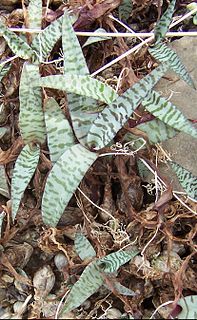
Echeveria is a large genus of flowering plants in the family Crassulaceae, native to semi-desert areas of Central America, Mexico and northwestern South America.

Zamia is a genus of cycad of the family Zamiaceae, native to Mexico, the West Indies, and Central and South America as far south as Bolivia. The range of one species (Z. integrifolia, extends into the contiguous United States, i.e. Georgia and Florida.

Westringia is a genus of Australian shrubs. As with other members of the mint family their upper petal is divided into two lobes. There are four stamens - the upper two are fertile while the lower two are reduced to staminodes. The leaves are in whorls of 3 or 4.

Ledebouria is a genus of African bulbous perennial herbs in the Asparagus family, Asparagaceae, subfamily Scilloideae. Most members were previously part of the genus Scilla. A number of species are grown by cacti and succulent enthusiasts for their patterned leaves.
Othonna is a genus of approximately 90 species of succulent or subsucculent perennial herbs or shrubs, with its center of diversity in the Greater Cape Floristic Region (GCFR) of South Africa but some species' ranges include southern Namibia, Angola, and Zimbabwe. The genus was established by Linnaeus in 1753 containing 14 species, however, of those original species, only four are still retained in Othonna, while the others have been transferred to different genera including Cineraria, Euryops, Hertia, Ligularia, Senecio, and Tephroseris. The genus Othonnna is known to be monophyletic. In 2012, a new genus Crassothonna B. Nord. was erected with 13 species transferred from Othonna. A complete modern taxonomic treatment of the genus is being undertaken by the Compton Herbarium, South African National Biodiversity Institute and, and the first part, a revision of the Othonnna bulbosa group was published in 2019.

Bulbine is a genus of plants in the family Asphodelaceae and subfamily Asphodeloideae, named for the bulb-shaped tuber of many species. It was formerly placed in the Liliaceae. It is found chiefly in Southern Africa, with a few species extending into tropical Africa and a few others in Australia and Yemen.
Zamia cremnophila is a species of plant in the family Zamiaceae. It is endemic to the state of Tabasco in Mexico, between Teapa and Tapijulapa.

× Cremnosedum is a hybrid genus produced from crosses involving the genera Cremnophila and Sedum. This bigeneric name was first published in 1981 with the introduction of the cultivar 'Little Gem' in an article advertising plants offered by the International Succulent Institute in the Cactus and Succulent Journal, the journal of the Cactus and Succulent Society of America. The 'Little Gem' cultivar was made by Mrs. and Mr. Robert Grim of San Jose, California and is described as producing a low mat of small rosettes. It prefers direct sunlight and produces small yellow flowers on short stalks.
Cremnophila is a genus of snout moths. It was erected by Ragonot in 1893, and is known from Russia, Siberia, China, Austria, and Switzerland.
Cremnophila sedakovella is a species of snout moth in the genus Cremnophila. It was described by Eduard Friedrich Eversmann in 1851 and is known from Russia, Austria, Switzerland, Italy and Spain.
Westringia cremnophila, commonly known as Snowy River westringia, is a rare shrub that is endemic to Victoria, Australia.

Oscularia is a genus of succulent flowering plants in the family Aizoaceae, native to semi-arid and rocky habitats in the Western Cape of South Africa.

Astroloba is a genus of flowering plants in the family Asphodelaceae, subfamily Asphodeloideae, native to the Cape Province of South Africa.

Buffelspoort, is a deep gorge and river valley situated in the Western Cape province of South Africa.
Boronia cremnophila, commonly known as the Kimberley cliff boronia, is a plant in the citrus family, Rutaceae and is endemic to a small area in the Kimberley region of Western Australia. It is an erect or spreading shrub with both simple, and trifoliate leaves, and white sepals and petals, the sepals larger than the petals.
Ivania is a genus of flowering plants belonging to the family Brassicaceae.
Cremnophila may refer to:
Cremnophila is a genus of flowering plants belonging to the family Crassulaceae.








